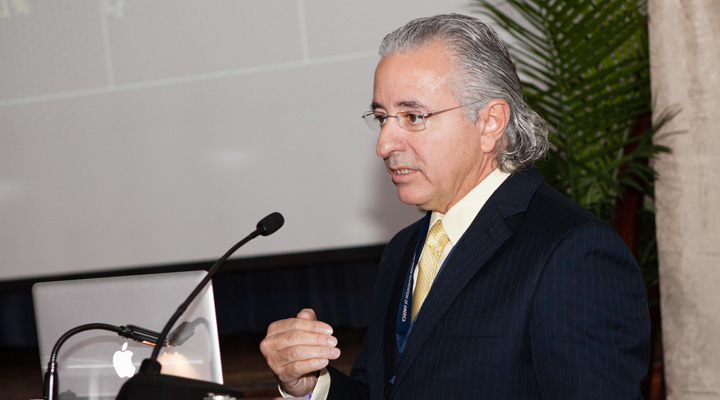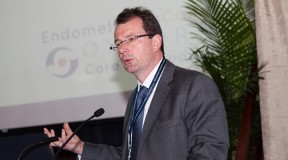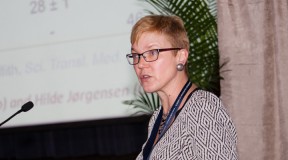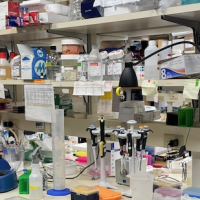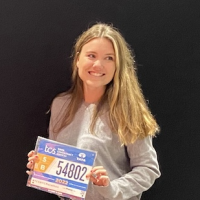Endofound’s Sixth Annual Medical Conference: Ending Endometriosis Starts at the Beginning
Diagnosis and treatment: surgery vs. no surgery?
Juan Salgado, MD
Thank you very much, good afternoon. Thank you to the…committee for their invitation and yes, I do look like Tamer Seckin. We do not know if we are brothers or not but we have one gene that is fight against endometriosis. We are together in that. We have to figure out who is the father.
I am going to talk today about endometriosis about surgery versus no surgery. This is my disclaimer.
First I want to start with a case that was presented by Dr. Maurice Chung the other day in Porto Rico. He was on vacation in Port Rico and I invited him to give a lecture to my residents. He started with this interesting case that really shocked me and made me more powerful to fight against unnecessary surgeries. This is a 29-year-old patient…with chronic pain pelvic pain after she had a trauma in her back. She started to seek a physician to treat her and finally she got this gynecological diagnostic laparoscopy which found that she had an endometrioma on her right ovary and it was removed. Six month later she had pain and she went to see another doctor. He did an exploratory laparotomy he did lysis of adhesions. He removed the uterus. A year later she went to another gynecologist and he did extensive adhesions with another exploratory laparotomy and removed the other ovary.
Guess what, she still has pain.
Finally she went to see Maurice Chung, he did a complete workup and she had a pudendal nerve neuralgia secondary to the trauma in her back. He treated her and gave her a block, PMR treatment and she is doing well but without children, without uterus, without ovaries and there was early menopause.
Everybody talks about this and we have 150 million people around the world with endometriosis. That is a prevalence of 10 percent. The average age of diagnosis is 28 years old. One third of them come with infertility and 80 percent come with pelvic pain but we have to know that 80 percent of the pelvic pain is not caused by endometriosis but is caused by other things that we have to keep in mind when we are doing the evaluation. There is a genetic correlation that we know. We know that there is deep endometriosis and superficial endometriosis. I am a firm believer that Sampson’s Theory explains the superficial endometriosis but even the deep endometriosis I am humbly more a believer that it is genetic predisposition of the patients and that they are born with that predisposition. It does not matter what you do you they are still going to have endometriosis.
The common sites we all know where they are. The less common sites, we can even find endometriosis in any part of the body.
I am going to show you this case. This is a patient I have that had three laparoscopies for ablation of implants and then she started to have umbilical pain and then she started to have bleeding. And when she has menstruation she bled through the umbilicus. They tried to do two surgeries to remove the mass that she was developing in the umbilicus. Finally she went to our office. We did a sonogram and she had 3.7 cm mass. We gave her Lupron until we got the mass to 2 cm. I got in touch with a plastic surgeon because I did not want to remove her umbilicus and leave her without one. We took her to the OR with these flaps here to make the umbilicus. This is the mass we went down to the fascia. This is how it now looks after the surgery and this is six months after the surgery. She is free of pain, no more bleeding and she is doing great.
Today I am supposed to talk to you about surgery versus no surgery. I was thinking about it when I was doing the lecture should I go there and teach all of these great surgeons of what they have to do in terms of surgery or no surgery? I decided to go to the literature and get good papers that talk about good recommendations for surgery. I found these five papers. The first one is the WES Consensus. We have the honor to have Lone here; she was a pioneer in this paper which for me is one of the most impressive papers that had all consensuses in every part of endometriosis. It is excellent. If you have not read it take a look. We have Endometriosis: an overview of Cochrane Reviews. They reviewed hundreds of papers. The ASRM made recommendations in publishing Fertility and Sterility in 2012 and ESHRE, Endometriosis Guideline Development Group which was published in 2013. Yesterday we had a couple of their recommendations. The last one is a paper I wrote with a group of people that I really admire, Maurice Abräo is one of my mentors in terms of sonography. It is very good in terms of recommendation of surgery prior to infertility evaluation.
We do not have too much time to go through all of them so I am going to give you some of what I took from each of them. Then I am going to do what I call a consensus. Of the consensus these are some of the recommendations. This is ESHRE in terms of pain and infertility. This is the Cochrane, there were only three reports for surgical interventions. And this was the Maurice Abräo and Chapron paper. I did the consensus of the consensus. What is recommended worldwide? To do surgery. Laparoscopy remains the cornerstone of accurate diagnosis of endometriosis. Laparoscopic surgical removal of endometriosis is an effective first line approach for pain, surgical removal, not ablation. So you will have to remove the lesions. Laparoscopy for endometriosis will always be undertaken in preference of laparotomy but this is not regarding birth rate or pregnancy rate it is regarding complications. We know that minor complications are 40 percent less in laparoscopy than laparotomy and major complications are similar so why are we going to do an open surgery when we can have less complications with laparoscopy? Endometrioma cystectomy is better than drainage. We have to counsel the patient with endometrioma for the ovarian reserve prior to the surgery.
This is a study done with patients that had ovarian cystectomy. They evaluated…hormone prior to the surgery, six weeks after surgery and six months after surgery. When we do surgery on a patient that has an endometrioma we have to think what type of patient this is – is it a 29-year-old patient with endometriosis that is causing infertility or if it is a 39-year-old patient with less ovarian reserve that has also been affected by endometriosis. These are two patients that we have to counsel in different ways and do…prior to the surgery.
This was a 31-year-old patient referred to our clinic. She had a 10 cm endometrioma. She failed the first IVF. The REA sent her to us to remove that endometrioma. We found in the sonogram that she also had deep endometriosis, bowel endometriosis. We did a conservative surgery for infertility. We went to the surgery to do laparoscopic ovarian cystectomy. This patient is now 30 something weeks pregnant with twins and she is doing great. I just did this part of the surgery. I did not remove any bowel and I did not remove anything else because it was very conservative surgery.
Best surgical approach for deep infiltrating endometriosis in terms of infertility is still unclear. When we do surgeries for infertility we just go to resolve the problem. If this is a hydrosalpinx we go there and we remove the tubes. If it is a myoma that is compressing the endometrial cavity and they failed IVF we go there. We lyse all the adhesions of the endometriosis we get there to the uterus, we remove the myoma and get out. We refer the patient back to the REA so he can do his procedure.
TLH and BSO are indicative after comprehensive evaluation and chronic pelvic pain has been reasonably attributed to endometriosis. Not everybody that has pain has endometriosis. We have other pains like Dr. …said this morning that mimics endometriosis. So do not go directly to treat endometriosis, do a workup, evaluate the patient completely as a whole, do not only look…and look in the pelvis.
Medical treatment is adequate in patients that are not seeking pregnancy after surgery. After we do a big surgery and if our patients are not seeking pregnancy we put them on hormones to prevent pain, to prevent recurrence, especially for those patients who have dysmenorrhea. We just give uninterrupted oral contraceptive.
But still there is a difference in the consensus. Europeans like to give hormones prior to the ART. The US and west do not recommend giving hormones prior to the in vitro fertilization. We still need more studies and get people together so we can give universally recommended guidelines.
But now that we know what type of surgery we are going to do if we are going to do a surgery we should do a preoperative evaluation. I am a true believer of this because I could find prior to the surgery what the patient has.
This is one of the best studies done in the literature about the comparison of clinical examination versus transvaginal sonography and magnetic resonance, MRI, in the diagnosis of DIE done by Mauricio Abräo in 2007. This changed our practice dramatically. Look at the results. Transvaginal sonography versus MRI in terms of sensitivities, specificity, PPV, NFV and accuracy in rectosigmoid lesions, it is impressive. We have a tool that is very easy to do, three Fleet enemas the day of the procedure at the office and the patient can have all of the information she needs. The conclusion? As you see, it is much better than the MRI and it has been compared with CT. I do not have time to show you all the papers comparing CT,…enema and rectal sonography. The vaginal sonography is the best tool you can use prior to surgery.
This is an abstract that we published and presented at the World Congress of Endometriosis in 2011. Everybody is trying to work in staging, like the ASRM, but we decided that we prefer to work in preoperative staging. I wanted to know how difficult the surgery is going to be so the surgeon takes the patient to the OR knowing what he is doing and not doing diagnostic laparoscopy to see what he has and then plan the surgery. What we did we took our sonographies to Brazil to train with Mauricio Abräo. He did the sonograms, I did the laparoscopy with Dr. Bracero, who is our RAI. Then we gave all the data from the sonogram and from the staging of the ASRM that we did in the laparoscopy to another institution, another school of medicine that is not related to us whatsoever so we would not have bias. We got very good results in predicting the complication of the surgery and the type of lesions the patient has.
You can see in the sonogram all the layers of the bowel and easily identify what type of surgery you have to do to that patient prior to getting the patient to the OR.
This patient has just a small lesion. She was very symptomatic. It only affected the serosa, the external muscularis not the sub-mucosa and not the mucosa. We shaved this lesion of the patient and the patient went from the office. When she went to the OR she knew she was going to have that type of surgery.
This is a patient who had more than 50 percent of circumference involvement of the lesion. This patient qualified for either discoid resection, double discoid resection that the Brazilians are doing now or a segmental resection. But this patient will know, prior to going to the OR that she will have a segmental resection. She will not have a surprise when she gets to the recovery room.
This one here tells me the distance between the lesion and the ana…and as you know less than 5 cm from the lesion to the ana…there is more probability of failure of the reanastomosis. In those patients our colorectal surgeons prefer to do an ileostomy. We do an ileostomy but when that patient wakes up in the recovery room she will know from my office before that she was going to have a bag. It is not that when she opened her eyes she found that she had a bag. It is very important to do this type of sonography so we can orient the patient of what they are going to have.
This patient is an example of a big lesion in the bladder. She knows from the beginning that when she leaves the hospital that she will go with a Foley for ten to 12 days but she will not be surprised that we had an accident and damaged the bladder while we were doing the surgery. She knew from the very beginning that she was going to have a Foley for that time.
So, the take home message; not every patient needs surgery, not everything that glitters is gold, we have a lot of different things to look at prior to doing surgery, we have different colleagues who are willing to cooperate with you with an endometriosis patient and willing to find other causes of the pain that are not endometriosis, and you do not have to do surgery. Do the transvaginal ultrasonography with bowel preparation and you will see the difference when you get to the OR. You know exactly what you are looking for. There were times when I could not find a lesion. I called my sonographer to the OR. We did the sonogram at the OR and he pointed where the lesion is and I just dive inside the peritoneal cavity and take the lesions out.
Do not be fooled when you do a laparoscopy. You think you are dealing with a superficial lesion, you shave it, you ablate it and you are really dealing with deep infiltrating endometriosis and it was just the tip of the iceberg. If you do not feel comfortable, refer the patient. There are good surgeons that would like to do the surgery. You have a group of different specialties; colorectal surgeon, general surgeon and urologist that are willing to do the surgery for your patient and return your patient to you.
My goal is to do only one complete surgery. I prepare the patient, I preoperative evaluate the patient and take her to OR and I do one complete surgery. At the end of the road we do everything for our patients. This is my lovely wife and daughter and every time I see a patient that is in front of me with three laparoscopies, four exploratory laparotomies, I see their faces and I know that I have a family that I want to see healthy, pain-free but most of all with no unnecessary surgeries. Thank you very much.
Dennis Connors: Thank you very much Dr. Salgado. It has been a pleasure to listen to you. Any questions?
Audience Member: Hi, I thought that was fantastic. I have two questions; one, I heard that you mentioned hormonal treatment. I wondered what your opinion was on the place of hormonal treatment with surgery? Like do they go hand-in-hand or are they at odds? We saw a lot of surgical talks yesterday and I wondered about the place. And my second question is, both the treatment and the diagnostic procedures for endometriosis seem very invasive, very traumatic especially to younger women, even TVU, so I was wondering if you think there is a place for empiric diagnosis using hormonal treatments? For instance the oral med that somebody mentioned earlier.
Juan Salgado, MD: Yes, for the first question we give hormonal treatment for the patients that are not going to get pregnant after the surgery. We resolve the problem. We take the pain away and put them in hormonal therapy and they go together. If I have to follow the ASRM rules in the US because we are the US and my RAI does not give medications prior to the IVF so we go directly by the laws of the US. For the young population, little girls, I do not do diagnostic laparoscopy I try them empirically first with oral contraceptive. If they do not respond then we sit with the family and decide what we are going to do. The sonogram can be done with the girls. We put the probe in the peritoneal area and we can see the rectosigmoid and the rectum. We can go then through the abdomen with a full bladder and also see the superficial part of the ovaries and everything as a normal pelvic sonogram. But the most important part is the three Fleet enemas. If you clean that bowel you will see everything. There is robust literature that I did not bring today because of lack of time but that is another lecture we can talk about later.
If you do not have the service at your hospital where you work or your university I am more delighted to go with Nanette. We give lectures. We will teach you how to do it. Take your patients, we will teach you and you will see what a difference that will make in your practice, and how different it will be not only for you but for your patients.
Rob Taylor, MD: Juan, very, very nice. How many cases do you feel like you need to see to train yourself to do these sonographic evaluations, particularly the deeply invasive lesions?
Juan Salgado, MD: I was trained with sonography when I was doing my residency program. I think that most of us here have that training. You have the knowledge and the thing is to do the bowel preparation. I took me, I went to Brazil, with Mauricio for three weeks then I went back to Porto Rico and I went back and did surgeries in the morning, sonography in the afternoon.



